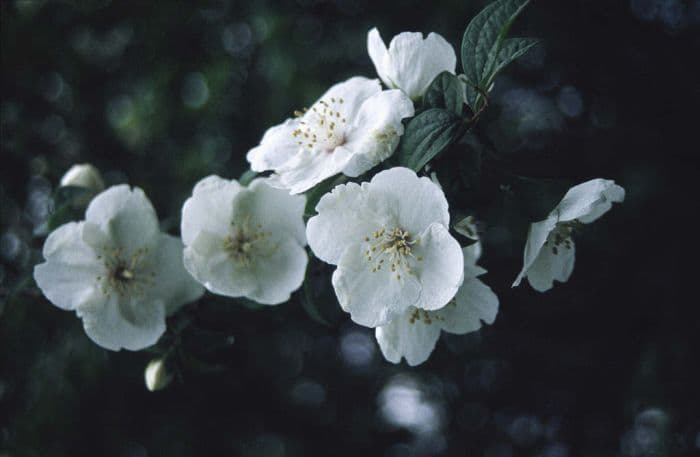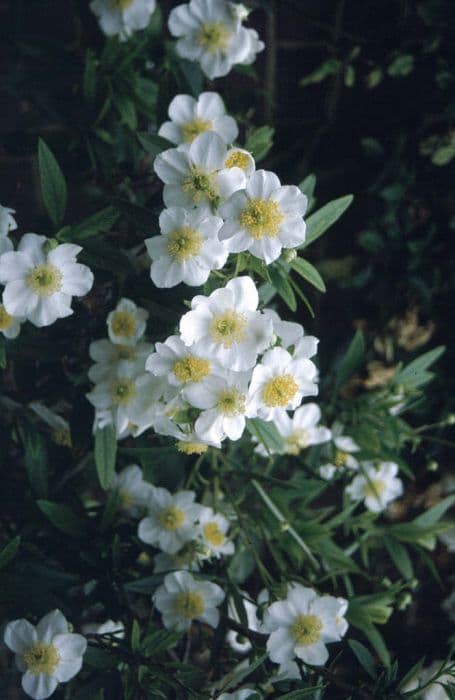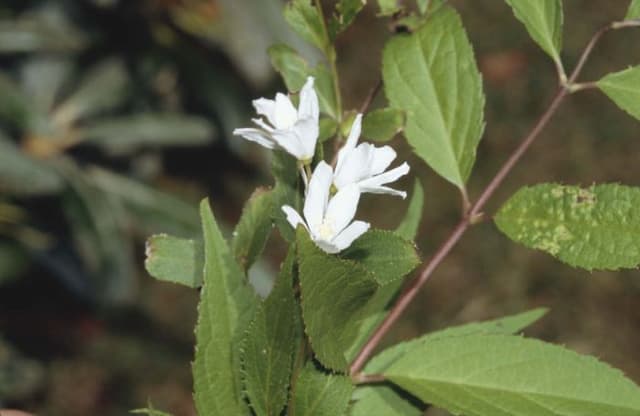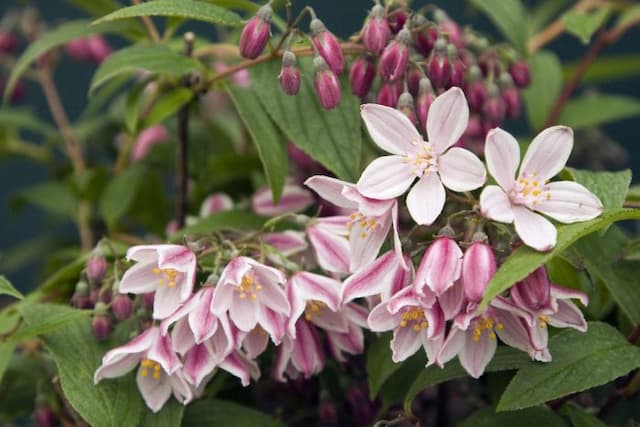Mock Orange Philadelphus 'Beauclerk'

ABOUT
Philadelphus 'Beauclerk', commonly known as Mock Orange, is a deciduous shrub known for its highly decorative appeal. This plant boasts a profusion of white flowers that are noted for their four-petaled, cross-shaped appearance. These blossoms usually exude a delightful, sweet fragrance reminiscent of orange blossoms, from which the plant gets its common name. The flowers are clustered in groups, creating a splendid display in the late spring to early summer. The leaves of the Mock Orange are medium to dark green, with a slightly glossy texture and an oval to oblong shape. They can provide a lush backdrop to the striking white flowers, enhancing the shrub's overall beauty. When not in bloom, the plant maintains interest with its foliage and the structure provided by its branches. The attractive peeling bark on mature stems adds another layer of visual interest, especially during the dormant season when the leaves have fallen. The overall form of the shrub is somewhat rounded, and it presents as a dense bush with a casual elegance, making it a popular choice for garden landscapes designed for aesthetic appeal.
About this plant
 Names
NamesSynonyms
Mock Orange, Sweet Mock Orange, English Dogwood
Common names
Philadelphus 'Beauclerk'.
 Toxicity
ToxicityTo humans
The common name for Philadelphus 'Beauclerk' is Mock Orange. Mock Orange is not considered toxic to humans. There are no well-documented cases of poisoning or harmful effects from ingesting the plant. Therefore, there are no specific symptoms associated with Mock Orange poisoning in humans.
To pets
The plant known as Mock Orange or Philadelphus 'Beauclerk' is generally not considered toxic to pets either. There is no significant evidence to suggest that eating parts of the Mock Orange plant will cause poisoning in pets. As with humans, there are also no specific symptoms of Mock Orange toxicity reported for pets. However, ingestion of non-food items by pets can sometimes lead to gastrointestinal upset regardless of toxicity, so it is best to prevent pets from eating plants not meant for consumption.
 Characteristics
CharacteristicsLife cycle
Perennials
Foliage type
Deciduous
Color of leaves
Green
Flower color
White
Height
6-8 feet (1.8-2.4 meters)
Spread
5-7 feet (1.5-2.1 meters)
Plant type
Shrub
Hardiness zones
5
Native area
Asia
Benefits
 General Benefits
General Benefits- Attractive Fragrance: The Philadelphus, commonly known as Mock Orange, has strongly scented white flowers that can add a delightful fragrance to the garden.
- Ornamental Value: With its beautiful, cup-shaped white flowers, Mock Orange boasts high ornamental value, enhancing any garden aesthetic.
- Wildlife Support: The flowers of Mock Orange attract bees and other pollinators, supporting local ecosystems.
- Hardiness: Philadelphus 'Beauclerk' is known for its hardiness and can withstand a variety of climates, making it a resilient garden addition.
- Low Maintenance: Once established, Mock Orange generally requires minimal care beyond occasional pruning to maintain shape and encourage flowering.
- Seasonal Interest: Mock Orange offers seasonal interest with its spring to early summer blooms and has pleasing foliage that adds greenery throughout the growing season.
- Privacy Screen: When planted in groups or as a hedge, Mock Orange can create a natural privacy screen for gardens and outdoor living spaces.
- Sound Barrier: The dense foliage of Mock Orange can help to muffle noise from roads or neighbors when used as hedging or a border plant.
 Medical Properties
Medical PropertiesThis plant is not used for medical purposes.
 Air-purifying Qualities
Air-purifying QualitiesThis plant is not specifically known for air purifying qualities.
 Other Uses
Other Uses- Perfumery: Mock orange blossoms have a rich, sweet fragrance, and their essential oils can be used in the creation of perfumes and scented products.
- Floral Arrangements: The blossoms of mock orange are often used in floral arrangements for their aesthetic appeal and delightful scent.
- Photography: The plant's picturesque flowers make it a popular subject for photographers, particularly in spring when they are in full bloom.
- Garden Design: Mock orange can be used as a focal point or background plant in garden design due to its size and showy flowers that appeal to landscapers and gardeners.
- Educational Tool: Botany students often study the mock orange plant to learn about its growth patterns and flowering cycle.
- Culinary Garnish: While not commonly eaten, the flowers can be used as decorative garnishes for desserts or dishes, provided they have not been treated with pesticides.
- Craft Projects: Dried mock orange flowers can be incorporated into craft projects like potpourri, sachets, or homemade paper.
- Wedding Decor: Because of its romantic fragrance and appearance, mock orange is used in wedding bouquets and decor.
- Fragrant Pathways: Planting mock orange along walkways or near windows can provide a natural, sweet fragrance that wafts into adjacent areas.
- Artistic Inspiration: The plant's beauty has often been captured in paintings, poems, and other art forms for its symbolic representation of purity and innocence.
Interesting Facts
 Feng Shui
Feng ShuiThe Mock Orange is not used in Feng Shui practice.
 Zodiac Sign Compitability
Zodiac Sign CompitabilityThe Mock Orange is not used in astrology practice.
 Plant Symbolism
Plant Symbolism- Renewal: The Philadelphus 'Beauclerk', commonly known as the Mock Orange, typically blooms in the spring or early summer, symbolizing new beginnings and the rejuvenation of life.
- Innocence: With its pure white flowers, Mock Orange is often associated with innocence and purity, making it a frequent choice for bridal bouquets and decorations.
- Brotherly Love: The genus name "Philadelphus" is derived from the Greek words 'philos' meaning loving and 'adelphos' meaning brother, translating to brotherly love which the plant represents.
- Memory: The strong and sweet fragrance of the Mock Orange flowers is thought to evoke and hold memories, linking it to reminiscence and nostalgia.
 Water
WaterMock orange should be watered deeply once a week, allowing the soil to dry out slightly between waterings. In the absence of rainfall, you might need to water the plant more frequently, especially during hot, dry periods. Generally, aim to provide about one gallon of water per watering session for an established plant, ensuring that the water penetrates the soil to reach the roots. For newly planted mock oranges, water every couple of days to help establish the roots. During winter, reduce the frequency of watering since the plant's water requirements decrease.
 Light
LightMock orange thrives in a location with full sun to partial shade. It performs best with at least four hours of direct sunlight each day, but it can tolerate some light dappled shade, especially in hotter climates. Avoid deep shade, as this can reduce flowering and lead to leggy growth.
 Temperature
TemperatureMock orange is hardy and can tolerate a wide range of temperatures, from winter lows around 10°F to summer highs well above 90°F. Ideal growing temperatures for the plant fall between 60°F and 75°F. However, it is important to protect the plant from extreme temperatures, both hot and cold, to prevent damage.
 Pruning
PruningPrune mock orange immediately after it blooms to shape the plant and encourage the growth of new flowers for the next season. Prune out any dead or damaged wood and reduce the length of the stems by about one-third to maintain a healthy, pleasing shape. Annually pruning will also help rejuvenate older plants. The best time for pruning is late spring or early summer, just after the flowering period ends.
 Cleaning
CleaningAs needed
 Soil
SoilThe Mock Orange 'Beauclerk' thrives in well-draining soil enriched with organic matter, such as compost or peat moss. A soil mix with a pH ranging from 6.0 to 7.5 is ideal, which is slightly acidic to neutral. Ensuring the soil is fertile and not prone to waterlogging will contribute to the plant's overall health and flowering performance.
 Repotting
RepottingMock Orange 'Beauclerk' is typically grown in the ground and does not require frequent repotting. If grown in a container, repotting every 2-3 years or when the plant becomes root-bound is sufficient. Spring is the best season to repot to minimize stress on the plant.
 Humidity & Misting
Humidity & MistingMock Orange 'Beauclerk' tolerates a wide range of humidity levels and does well in typical outdoor humidity. This plant does not have specific humidity requirements, so it can be grown in most climates without concern for creating additional humidity.
 Suitable locations
Suitable locationsIndoor
Ensure bright indirect light and room to grow.
Outdoor
Plant in full sun to part shade; mulch to retain moisture.
Hardiness zone
4-8 USDA
 Life cycle
Life cycleThe life cycle of Philadelphus 'Beauclerk', commonly known as Mock Orange, begins with seed germination, which is often erratic and can take several months. After germination, the seedling stems elongate and form true leaves, entering the juvenile vegetative stage, where it focuses on root and shoot development. As the plant matures, it transitions to the adult vegetative stage, characterized by the growth of more robust woody stems and foliage. The Mock Orange then enters the flowering stage, usually in late spring to early summer, producing fragrant white blossoms that attract pollinators. Following pollination, the plant develops small, inconspicuous fruit which contains seeds, completing the reproductive cycle. After several years, once the plant has reached the end of its life span, which can be several decades, it will eventually die, leaving seeds to restart the life cycle.
 Propogation
PropogationPropogation time
Spring-Early Summer
The Philadelphus 'Beauclerk', commonly known as the mock orange, is typically propagated by softwood cuttings taken in late spring to early summer when the plant is actively growing. To do this, you'll need to select a healthy stem that is about the thickness of a pencil and approximately 6 to 8 inches (15 to 20 centimeters) long. Cut the stem just below a leaf node, the point on the stem where leaves are attached, and remove the leaves from the lower half of the cutting. Dip the cut end into a rooting hormone to encourage root growth. Then, plant the cutting in a pot filled with a mix of peat and perlite, ensuring at least two or three nodes are buried in the soil mix. Keep the soil consistently moist but not waterlogged, and place the pot in a warm spot with indirect sunlight. Roots should develop within a few weeks, after which the young plant can be transplanted into a larger pot or directly into the garden.







![Hydrangea [Strong Annabelle]](/_next/image?url=https%3A%2F%2Fplants-admin.emdemapps.com%2Fimages%2Fplants%2F%2Fimages%2F604b54db37d34.png&w=640&q=75)

